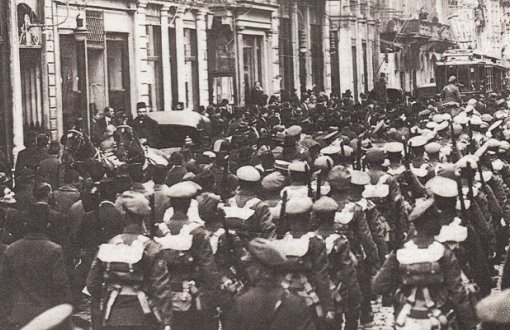Beyoğlu, İstanbul, in the occupation years.
The Hrant Dink Foundation has called for papers for a conference titled "İstanbul 1914-1922: War, Collapse, Occupation, and the History of Resistance," which will take place on November 4-5 in İstanbul.
The conference will cover three major themes in this eight-year period, the foundation said.
The first one is the struggle of İstanbul's Muslim and non-Muslim communities during the World War I, between the fall of 1914 when the Ottoman Empire entered the war and the Armistice of Mudros in October 1918.
"The inhabitants of the capital, who carried the burden of the war ... suffered under the oppressive policies of the Committee of Union and Progress (İTC/CUP) governments, military censorship, corruption, hunger, and poverty.
"For the Muslim and non-Muslim people of Istanbul, who were trying to get news from their husbands, fathers, and brothers who were recruited during the mobilization or exiled to some cities of Anatolia, the war years meant wear and tear in the face of high inflation and economic collapse."
The armistice and the post-CUP era
"The escape of the CUP leaders from the country after the signing of the Armistice of Mudros on 30 October 1918 and the occupation of Istanbul by the Allied Powers were a turning point.
"During "the armistice" period between 1918-1922, journalists escaped the pressure of censorship. Opposition journalists in exile returned to Istanbul and took over their newspapers.
"Newspapers now described the destruction, exile, and massacres that took place at the front lines and in Anatolia during the war. Meanwhile, the tragedy that some non-Muslim children experienced during the war years was revealed. Thousands of orphaned children were given to Muslim families for adoption."
The conference will also discuss the "National Struggle" period that began in 1919 and ended in the foundation of the Republic of Turkey.
While the movement developed in Anatolia, İstanbul was the center where it was organized in terms of financial support and recruitment, the foundation noted.
White Russian émigrés
For the last part, the conference will discuss the "White Russian émigrés," about 200,000 former elites of the tsarist Russia who took refuge in İstanbul after they were defeated by the revolutionaries.
"The novelties they brought to the social life of Istanbul had a lasting impact on the city. In addition to the White Russians, Istanbul has been a port where Armenians returning from exile or Muslim immigrants fleeing the regime changes in neighboring countries took shelter."
The conference will be in Turkish, Armenian and English with simultaneous translation. The researchers willing to participate in the conference are requested to submit their work by May 13.
You can see further details about the conference on the Hrant Dink Foundation website. (VK)




